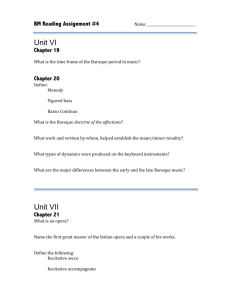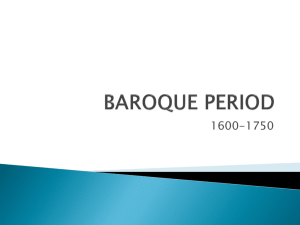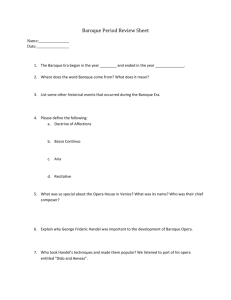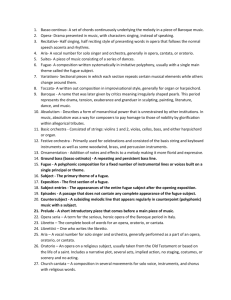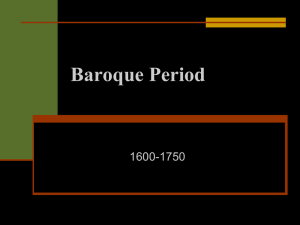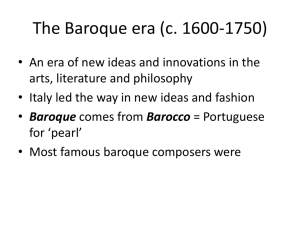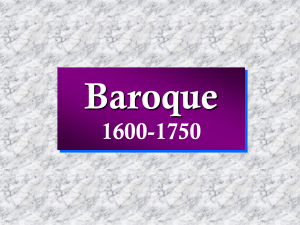Baroque
advertisement
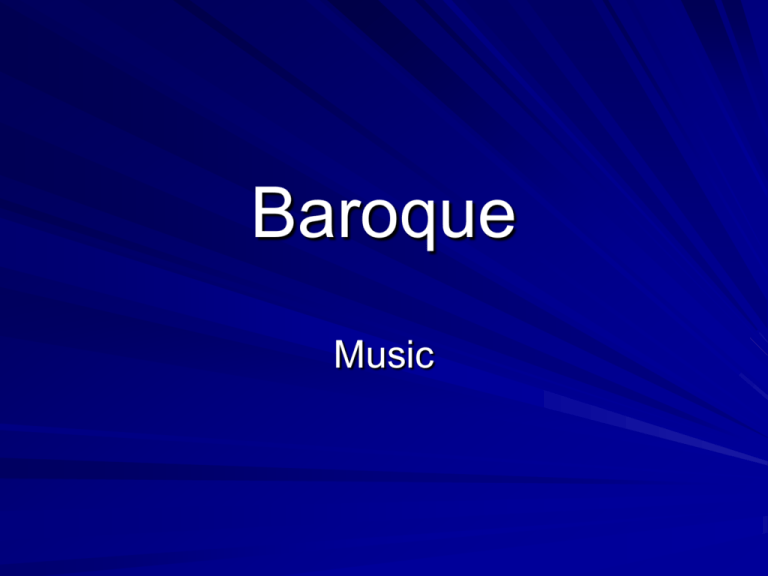
Baroque Music Bach Johann Sebastian Bach – 1685 – 1750 – Born in Germany – Recognized as a master of polyphonic (“many sounds) style and great organist – Known for his fugues Fugue Repeating of a melody by different instruments with some variations. Generally consists of a series of expositions - consists of subjects with at least one answer Fugue Parts of the fugue: – Subject melody that comprises the primary melodic material – Answer subject imitation; immediately follows the subject but usually in a different voice (higher or lower) – Countersubject sometimes recurs immediately following the subject or answer – False subject entry of the subject that begins but never finishes Handel George Frideric Handel – 1685 – 1759 – British composer of operas and oratorios – most famous works Messiah Water Music Music for the Royal Fireworks. Oratorio large musical composition for orchestra and chorus – often with a biblical theme – different than opera no acting, no scenery, no costumes Messiah Oratorio presentation of Jesus' life 1741 (completed in 24 days) – Handel is at his peak but depressed and in debt Handel conducted Messiah many times and often altered the music to meet the needs of his musicians and singers Because of this, no single version can be regarded as the authentic one Baroque Dance Ballet Formalized “Performance Dance” Earliest roots can be traced to Italy in the 15th century Featured trained dancers and choreography Organized and formally structured in France by Pierre Beauchamp in the early 1600s Terminology (Vocabulary) is largely French (e.g. pirouette, piqué, plié, poisson Features a “turned-out” body position Louis XIV of France (1643-1715) Known as the “Sun King” Became king at age four An accomplished ballet dancer In 1661, founded the Royal Academy of Dance (Académie Royale de Danse) Would often take lead roles in ballet performances at the royal court Louis XIV as the Sun King This nickname came from a ballet role in which Louis performed when he was 14. He liked the costume and the imagery so much that he adopted the name and fashioned a sun emblem to represent himself. The Greek god Apollo was the god of the sun, peace, and the arts – another association that appealed to Louis Louis’s Home – The Palace of Versailles Pierre Beauchamp (1631-1705) • • • Ballet choreographer and dancer Director of the Royal Academy of Dance Credited with codifying the five foot positions used in ballet and in the development of the use of the arms Baroque Theatre Molière (1622-1673) Born Jean-Baptiste Poquelin, he was know as Molière, a stage name French playwright and actor Considered one of the greatest masters of comedy in western literature Two of his best known works include Tartuffe (the Hypocrite) and Le Misanthrope. Baroque Opera Although Opera would not reach its pinnacle until the Classical and Romantic Periods (1750-1900), it can trace it’s roots to the Baroque time period. Opera is an art form in which singers and musicians perform a dramatic work combining text (called a libretto) and musical score Opera included costumes, props, and sets and would have a secular theme – often focused on stories from ancient Greece and Rome. In between acts of an opera, a ballet would often be performed.
